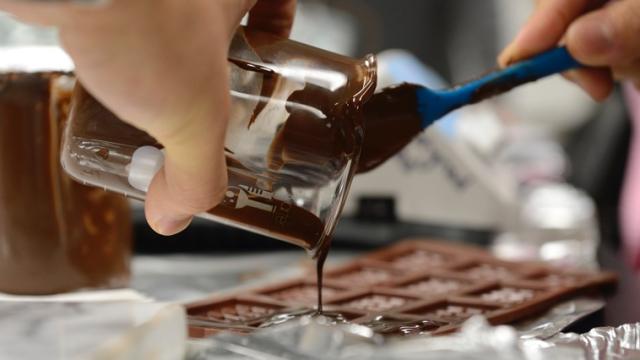We all know what happens when a chocolate bar sits inside a backpack on a really hot day: it melts, and even if it resolidifies, it will never quite look the same. But what if you could tailor your chocolate to have a higher melting point?
You probably can, just by mastering a few basics of materials science, according to Jennifer Dailey, a graduate student in materials science and engineering at Johns Hopkins University. She recently taught a short course using chocolate to introduce 20 students to the concepts behind how atomic (or molecular) structure determines the properties of a given substance — in this case, Valrhona chocolate.
Look at different chocolate samples under a scanning electron microscope (SEM), as Dailey’s students did (at magnifications ranging from 400 to 5000 times), and you’ll see that each has a slightly different crystal structure. It’s all chocolate, but each is a different so-called “allotrope“. As Ethan Siegel writes over at Forbes:
While carbon can form diamond, graphite, nanotubes, buckminsterfullerenes or even pencil lead depending on how it bonds together, chocolate can take on six different distinct crystalline structures, depending on how the chocolate molecules assemble next to one another. If you want to sound fancy, this means that chocolate is a six-phase polymorphic crystal.
Mess with the crystal structure, and you mess with the chocolate’s basic properties. “So much of materials science is just figuring out how we can make the structure that we want [to get] certain characteristics for a particular use,” said Dailey — like tweaking the melting point of your chocolate. The key there is getting just the right ratio between milk fat and cocoa in your chocolate. Dark chocolate has a higher percentage of cocoa in proportion to milk fat, so it has a higher melting point. Dark chocolate melts in your mouth; milk chocolate is much more likely to melt in your hand.
This was the basis of the chocolate tempering experiment Dailey had her students perform as part of the course. “We went through all these phase diagrams showing what crystals would appear at what temperatures,” she said. In the first phase, they heated the chocolate until it was a liquid, with no more crystals, then cooled it down just enough so that a few crystals started to form. But not all crystals are created equal; in this case, the students wanted just those crystals that had a higher melting point.
The trick is to heat the chocolate up a second time, by just a few degrees. This destroys the unwanted crystals (like those with a lower melting point). Then they poured the liquid into moulds and let it set. If all went well — that is, if the students controlled the temperature perfectly during the tempering process — the end result was a piece of smooth, silky chocolate.

Best science lab ever. Jennifer Dailey and her JHU students experimenting with chocolate. Credit: Will Kirk/Johns Hopkins University
Perhaps you’ve felt the dismay of finding white spots in an otherwise pristine hunk of chocolate. Dailey says those are either sugar crystals or flat globules. In the case of the former, those crystals form when chocolate gets wet, or is exposed to a humid environment. Sugar is very soluble in water, so it dissolves, then the water evaporates, and you’re left with sugar crystals on the surface of your chocolate.
And what about that old block of baker’s chocolate that’s been festering in your pantry for a year or so? In that case, the white spots would be fat globules, and while it doesn’t look pretty — and would have a weird gritty mouthfeel because those globules aren’t evenly dispersed throughout the chocolate — Dailey swears it’s perfectly safe to eat. Put it through the tempering process, and your questionable-looking choco-block will be good as new.
Doing experiments with chocolate is fun and all, but did the students truly learn anything tangible? To find out, Dailey ran a separate experiment on the side. She gave pre- and post-course tests both to her chocoholic students, and to juniors taking a traditional thermodynamics class — where the focus is on metals like steel, gold, or copper rather than chocolate — just to see which group learned the material the best. “My chocolate students started at a lower level, just because half of them are coming from the humanities,” she said. “But they had identical ending scores. It made me so happy. They learned.”
Alas, her students didn’t get to actually eat their experimental chocolate, since all this took place in the department’s materials science laboratory, around a bunch of substances that it’s not really wise to eat. Also, for the SEM imaging, they had to sputter a thin coating of platinum across the surface, since chocolate is an insulator, not a conductor. (SEM exploits electrons for imaging, so without that coating, there would have been no images of the chocolate.) Dailey made it up to them by bringing in a local chocolatier she met at a farmer’s market, who let the students sample his wares.
Credit: Will Kirk/Johns Hopkins University.
